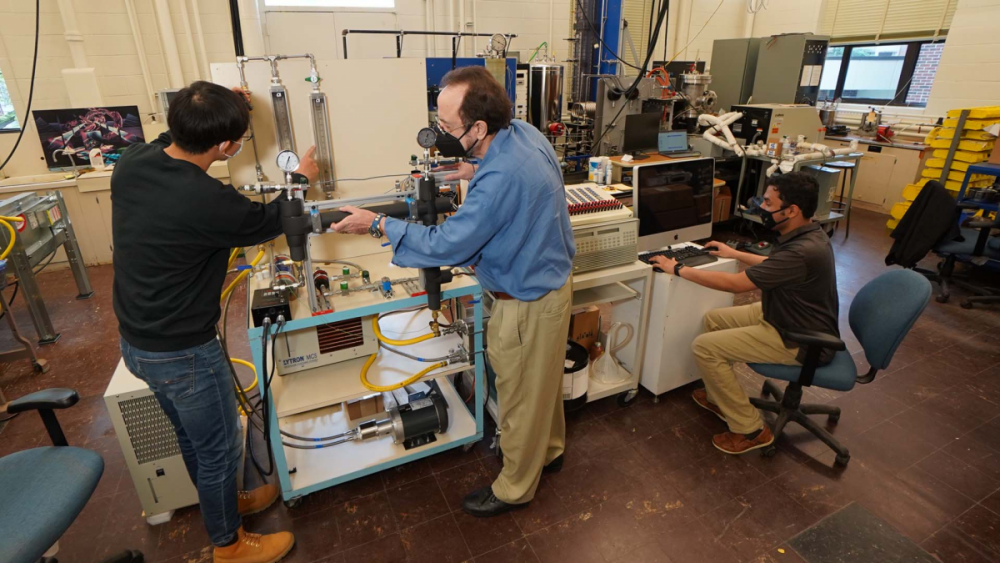Search the Community
Showing results for tags 'charging'.
-
https://www.channelnewsasia.com/singapore/electric-vehicles-ev-charging-points-hdb-car-parks-2025-2547471 Nearly 2,000 HDB car parks to have at least 3 EV charging points each by 2025 File photo of an electric vehicle (EV) charging point in Singapore. (Photo: iStock/taikrixel) Grace Yeoh Grace Yeoh 08 Mar 2022 01:37PM (Updated: 08 Mar 2022 01:37PM) Bookmark Share SINGAPORE: To make every Housing and Development Board (HDB) town “EV-ready” by 2025, nearly 2,000 HDB car parks will each have a minimum of three charging points. These charging points will “mostly provide low-powered, overnight charging”, to meet the needs of car owners and minimise the load on the electrical grid, said Transport Minister S Iswaran on Tuesday (Mar 8). Advertisement Speaking during a multi-ministry joint segment on the Singapore Green Plan 2030 at the Committee of Supply debate, Mr Iswaran said more charging points will be installed in car parks where there is demand and adequate electrical capacity. The Land Transport Authority (LTA) said in a press release that the move is a “significant step” in achieving Singapore’s target of 60,000 EV charging points by 2030. A “large-scale tender” for HDB car parks will be launched in the first half of this year, it added. Singapore’s land transport emissions peaked at 7.7 million tonnes of carbon dioxide equivalent (MtCO2e) in 2016 - way ahead of the 2030 timeline set at the national level, LTA said. As such, the Government has set a new target of reducing emissions by 80 per cent from the 2016 peak by around 2050.
- 72 replies
-
- 1
-
.png)
-
- ev charging
- charging
-
(and 3 more)
Tagged with:
-

How Much Range Does an Electric Car Lose Each Year?
kobayashiGT replied to kobayashiGT's topic in Electric Cars
Source: https://www.axios.com/2025/03/17/byd-charging-tesla?lctg=202885 China continues to raise the bar on electric vehicles, with BYD unveiling a new EV platform that can be recharged about as fast as it takes refuel a gasoline car. Why it matters: Making EV charging as painless as visiting a gas station is one less hurdle for consumers, and could help spur widespread EV adoption. It's also a further sign of the growing dominance of BYD, which sells both electric vehicles and hybrids, while onetime EV leader Tesla's fortunes wane, both in China and the rest of the world. Driving the news: BYD's new battery and charging system can provide nearly 300 miles of driving range in 5 minutes, chairman and founder Wang Chuanfu said Monday, Bloomberg reported. The 1,000-Volt Super e-Platform will underpin BYD's next-generation vehicles, starting with the Han L sedan and Tang L SUV. BYD also said it would build more than 4,000 ultra-fast chargers across China to match the new EV platform. Between the lines: The charging breakthrough, while promising, is light on specifics. It's not clear what type of battery chemistry is used to achieve such results. Also unknown is the battery size, or maximum sustained power levels during charging. The big picture: What is clear, however, is that Chinese manufacturers are outpacing the U.S. and European Union on EV charging technology. "Tesla has definitely moved from leader to laggard in EV battery and charging technology at this point." said Matt Teske, founder and CEO of Chargeway, a startup aiming to simplify EV charging. Tesla's latest "V4" Superchargers offer 325kW power — a step in the right direction, Teske said — but Tesla vehicles need 800V battery tech in order to take full advantage of those faster chargers. Currently, Tesla's vehicles have a 400V system, which limits how fast they can accept electrons, no matter how fast the charging equipment. Competitors including Hyundai, Kia and Porsche have more advanced 800V systems, the fastest-available before BYD's 1,000V breakthrough. The bottom line: Convenient, fast EV charging requires higher-voltage battery technology mated with chargers capable of sustained power delivery at maximum speeds. Not even China has cracked that problem yet, but BYD is getting closer. -
As the title suggests, I have never charged my phone in the car. However it looks to be a more plausible option . Loads of info and most suggest it’s ok using the ciggy plug adaptors, wireless pads OR the usb/usb-C sockets provided . Any long term effects on the car battery ? Discuss
-
This informative video explains the real world challenges that electric vehicles are facing, which is not about the cost, battery technology and range.
-
Can afford Tesla, cannot afford to charge? Just go to your nearest condo I guess. What happened? A Tesla Model Y at Sol Acres condominium was reported to have broke the lock to a wall plug to charge using the condo’s electricity, despite not being a resident vehicle. Pictures in the Facebook post show that the Tesla was using a wall plug in order to charge the car. The plug was apparently locked and subsequently broken, though no signs of damage were shown in the photo. According to a forum post on Tesla Motors Club, it might take 30-40 hours to charge the car up from empty using a 13A wall plug like in the picture. So the owner will have to leave the car there for 30-40 hours, by which time maybe security will get wise and put clamps on the car. If that happens, they would need to pay to remove the wheel clamp so the whole ordeal would have cost about the same plus the additional wasted time and embarassment. Online chatter Many presented very simple solutions to this problem. Many also ridiculed the Tesla owner for buying such a car but being unable to charge it. ========= Be the first to get the latest road/ COE news and get first dibs on exclusive promos and giveaways in our Telegram SGCM Community. Join us today!
- 1 comment
-
- tesla
- tesla model y
-
(and 7 more)
Tagged with:
-
If you're a new EV owner who is wondering how to avoid range anxiety and get the most out of your new car, here's a quick primer for you! More and more people are now electrifying their drives with EVs. To get the most of your new EV and soothe any range anxiety, here's what you should and shouldn't do. Charge+Charging 1. Plan your charging schedule with your lifestyle Based on the average daily mileage of about 50km for private cars in Singapore, most EV owners would only need to charge their cars once a week. You can easily incorporate this once-a-week session into your lifestyle by choosing to charge your car overnight. This option, also known as slow charging, uses alternating current (AC), is not only convenient for drivers, but it also poses a much lower burden on the electrical infrastructure. Similar to charging your mobile phone overnight, you can do the same for your EV and wake up to a fully charged car. Most public charging points in Singapore at shared residential carparks are slow chargers that support overnight charging. On the other hand, if you prefer to dovetail it with your regular activities such as buying groceries, getting a haircut, or even just having breakfast with your family at a nearby cafe while your car is being charged, you can opt for fast charging that uses direct current (DC), which is available at some shopping malls, office buildings, and even select petrol stations. 2. Use the MyTransport.SG app to find the nearest charging point By 2025, every HDB town will be EV-ready, which means there will be charging points in nearly 2,000 HDB carparks over the next three to four years. By 2030, there will be around 60,000 charging points! No need to worry, though, because finding one near your most frequented places or in a building where you'll be meeting clients for an appointment has been made easier with the MyTransport.SG app. Once you have the app on your phone, you can quickly access information on where you can find the most convenient charging spot. MyTransport.SG doesn't just display available charging locations, though. It also shows you the type of plug, power rating, and price. This offers drivers convenience and enables them to make informed decisions. You can also use the app to filter and search for charging points, be redirected to the respective charging operators' apps to make payments, or to Google Maps for navigation. Very handy. 3. Park in an EV lot only when charging EV charging points are meant specifically for that - to charge electric vehicles. Once you are done charging, do move your vehicle and park it in a regular lot, so that other EV users who wish to charge their car can do so. EV276 EV Charging 4. Charge only up to 80% While you may be tempted to fully charge your EV, sometimes less is more. Studies have shown that an EV's charging rate slows down once it reaches this level of charge, so you may want to consider unplugging at 80%, and save yourself time in the process. This also helps prolong your EV's battery life, so it's a win-win. 5. Return the charging gun properly Don't forget to place the charging gun firmly back in its holster when you're done. This helps prevent it from getting damaged (just imagine if it was left on the ground and it got run over by a car!) and reduces the risk of people tripping over the cable. There you have it! Charging an EV can be fuss-free and convenient. With these quick and easy tips, you can say goodbye to range anxiety and power up your EV the right way.
-
A local company has started offering a mobile charging service for electric vehicles (EVs). This is said to be the first of its kind in Singapore. The service by Power Up Tech (P.Up) is targeted at EV owners who may not have convenient access to a permanent charging point. Each visit lasts 30 minutes to an hour to bring the EV up to about 80 per cent of battery charge. So range anxiety is not a problem anymore. Maybe while waiting can also charge handphone. 😄
- 51 replies
-
- 11
-

-
- electric vehicle
- hybrid
-
(and 2 more)
Tagged with:
-
https://www.thedrive.com/tech/43155/ford-purdue-cooling-patent-could-charge-evs-as-fast-as-gas-station-fill-ups <Ford, Purdue Cooling Patent Could Charge EVs As Fast As Gas Station Fill-Ups Heat management is crucial to faster charging, and this patent has a built-in way to keep things cool. Battery science is a pretty undeveloped field, which is why we're still using lithium-ion instead of ultra-efficient metal air or sodium chemistry. During the period when burning fuel to generate power was always the easiest option, there wasn't a motivation to make storage a priority and when it comes to EV charging, from infrastructure to materials and methods, we're in the absolute infancy of what might get done. This is why it's extremely cool to see Ford working with Purdue University on a potentially game-changing charge cable. The patent's still pending and this isn't in the production stage, so it'd be years before it could be rolled out. But Ford has shared details about the research, which has come up with a solution that could drastically cut EV charging, Ford says, maybe even down to the same amount of time it takes to fill up a gasoline car. Before I dive into how it works, let's discuss the basics. One of the things about charging a battery, as anyone who's ever plugged their phone in on a warm day will know, is that it gets hot. And as you'll also know from plugging the charger in, it's not just the battery—the cable, the adapter, everything gets real warm because of the current flowing through it, especially as you increase that voltage for faster charging. You can lower how hot parts of it get by using higher-grade, less resistant materials but not only is there a financial cost to that, it also generally means you need rarer stuff and it's not like metals and minerals we're using for technology aren't already a problem. The heating up limits charging and causes the equipment, on the battery and charger side, to degrade faster. So one key to improving charging—which is to say, making it faster—is managing that heat. Ford's partnership with Purdue has come up with something pretty interesting, which is a cable made with liquid cooling built into it. PURDUE UNIVERSITY Liquid cooling is pretty fancy, in a battery—AMG is rightly pleased with its direct-liquid-cooled energy store that's basically apeing the Mercedes F1 battery—but it doesn't need spectacularly precious elements. Building it into a cable is clever enough in the first place, given the cable needs to flex but Ford and Purdue's research has also got a stage smarter than anything else around so far. The cooling agent that the cable uses switches between being a liquid and vapor, which is a heat-reductive process. Like the reason humans sweat, when something vaporizes it takes heat from its surroundings, wicking the excess away from the charging cable wires. That also doesn't require the liquid to be pumped around in order to circulate its heat reduction capabilities. Purdue mechanical engineering professor Issam Mudawar led on the project, alongside Ford's engineers. In Ford's news release, Mudawar said that a prototype cable should be being tested within the next 24 months, in order to work on seeing how much difference the cable makes to vehicle charging times and how much it increases potential current. That's very exciting, even if it's still a long way off being a production concern, especially because this isn't Ford saying it has a new type of proprietary plug, this is actually a new way to use cooling technologies altogether. Although there was quite a lot of bombast in Ford's release about this to say it could bring EV charging times down to equivalent to refueling, that bits in the handwave phase at the moment. We don't know how much it will actually improve charging times or if the system is, for instance, robust enough to withstand thousands of charge cycles—that's the point of research, that it's still getting worked out. But it's a nifty innovation and it'll be interesting to see where it goes.>
- 21 replies
-
- 3
-

-
.png)
-
- electric vehicle
- battery
- (and 6 more)
-
E-bike catches fire while charging in Yishun flat, 1 person taken to hospital SINGAPORE: One person was taken to hospital with burn injuries after a fire broke out in a Yishun flat on Saturday morning (Nov 14). The Singapore Civil Defence Force (SCDF) said it responded to a fire in a fourth-floor unit at Block 424A Yishun Ave 11 at about 9.45am. "Preliminary investigation into the cause of the fire indicates that it was of electrical origin from a Power-Assisted Bicycle (PAB) that was charging at the time of the fire," it said in a Facebook post. https://www.channelnewsasia.com/news/singapore/yishun-fire-e-bike-charging-scdf-burn-injuries-13546486
-
Toyota Covers Prius With Solar Panels That Also Charge Battery On The Move Automakers are looking to maximize the driving range of their plug-in hybrid and all-electric vehicles, and solar panels are the hottest solution right now — literally. Toyota is well aware of that and has announced a plan to begin public road trials from late July 2019 with Prius PHV vehicles equipped with high-efficiency solar batteries. The trials will take place in Japan and benefit from the support of Sharp Corporation and the country’s New Energy and Industrial Technology Development Organization (NEDO). As part of the program, Sharp will supply onboard solar battery panels using high-efficiency cells. According to the automaker, the goal is “to assess the effectiveness of improvements in cruising range and fuel efficiency of electrified vehicles equipped with high-efficiency solar batteries.” Toyota installed the Sharp-supplied solar panels on the roof, hood, rear hatch door, and other parts of the Prius PHV to produce a demo car for public road trials. Compared to the Prius PHV that’s already available with a solar charging roof system, the demo car is superior in every respect. At 860 W, the rated power generation output is 4.8 times bigger and the solar battery cell conversion efficiency exceeds 34 percent (versus 22.5 percent). Most importantly, the demo car uses a system that charges the driving battery both while the car is parked and when on the move. This development is expected to lead to “considerable improvements in electric-powered cruising range and fuel efficiency.” More specifically, Toyota claims the experimental vehicle’s daily maximum charge to the battery while the vehicle is parked is equivalent to a driving range of 44.5 km (27.6 miles), compared to the production car’s 6.1 km (3.8 miles). Things get better when the car is moving, as the daily maximum charge and power supply to the driving and auxiliary battery amounts to a driving range of 56.3 km (35 miles). The production Prius PHV’s solar charging system only supplies power on the move to the auxiliary battery, which powers the navigation and other systems. Toyota will conduct the trials under various driving conditions in Toyota City, Tokyo, and other areas in its homeland. The goal is to use resulting data for the development of an onboard solar recharging system. I know some are going to say it look like sh*t (tai gor in dialect), but given that it can provide energy for >50Km per day, I don't mind actually, not only to save my wallet, but our mother earth.
- 30 replies
-
- 10
-

-
Hi one of my car tire cannot be charged, suspect the charging valve is stuck. What should I do? Can the valve be replaced or must I change tire?
- 19 replies
-

Google Map can now show real time availability of charging ports
chitchatboy posted a blog entry in MyAutoBlog
Users of Google Map can now have real-time availability of charging ports at the charging station, removing the chances of driving there and finding no available slots for your Electric Vehicle. However, only owners in United Kingdom and United States of America can benefit from this updated function for now. That said, once Google gets this new feature inserted into future versions of the app for Singaporeans, users simply have to fire up the app and search for “EV charging stations.” A list of nearby chargers will then appear, showing how many open ports are available at each station. Other than that, the app can also display the charger type and the power rating. The new feature can be used with Google Maps on Android and iOS. It’s also integrated into Android Auto.-
- charging
- google map
-
(and 1 more)
Tagged with:
-
Would you buy a pure electric car like a Tesla S should there be.... 1) Ample charging stations in multi storey carparks or commonly available? 2) Companies such as Tesla set up their base here? Will that change the landscape of cars in SG should there be no tax on electric vehicles as of now?
-

2years old mazda 3 got slow charging battery, normal?
Mangos posted a topic in Maintenance & Repairs
Hi guys, I'm a new driver and just bought a 2nd hand Mazda which is close to 2 years old and close to 20k kms. So I sent it to Mazda service centre to do the 20k service this morning after driving it for a few days which I didn't notice any problem with the car. I just got a call from the Mazda technician telling me that the battery is charging very slowly and they suggest to replace it with a new one at the cost of S$145. I have very little knowledge about cars but after google a little bit I think the price is higher than purchasing from 3rd party but that I can accept since everything from the original manufacturer is more expensive than from open market. But a faulty battery on a 2 years old car, is that reasonable? how long does car batteries usually last. And any suggestions for a newbie on (consumable) car parts purchases in Singapore? And any recommended service/repair shop after warranty is over? or shall I stick to Mazda for service/repair? I live in Choa Chu Kang and work in Clementi so any suggestion closer will be appreciated. Thanks a lot! -
Just saw that Kia Niro has wireless charging built in.. Wow, me mountain tortoise, any other car in Singapore has this wireless charging? Thanks..
- 15 replies
-
Hi. New owner here. Have u all managed to successfully reclaim double charged parking (gantry type) before. Jus email the management?
-
There arent many Evs in singapore as theres not really an after sales infrastrature in place to support owning one and the lack of battery tech means that range is limited before a charge is needed. Furthermore as most of us live in hdb aparements, current recharging stations are not really widespread yet because they are mostly bulky,cumbersome and are located out of the way. This negativity causes many to overlook it as an alternative to petrol powered vehicles. Could there be a retractable reel like charging wire ( just the charging adapter from the shown charging point above)that comes down from above and retracts back into the ceiling once the charging is finished, like a wall socket ? This could enable many lots to be used as an ev charging point, especially if ev cars take off, or it may even spur ev ownership. Imagine charging your car at home without the need to fuel up at a petrol station. Or as an alternative,an EV charging station, which like a petrol station with the idea above. With the compact nature of the charging lot, it can even possibly be a multi level charging station, serving quite a number of cars, possibly more than what a petrol powered variant could do without the relative dangers of fuel vapours etc. Something like this Station staff collects the car, drives inside and parks the car in one of the ev station lots, and returns the car once the charging is done. Payment while waiting.
-
While not exactly relevant to us since the BMW i3s that we get here are the ones with the 650cc two-cylinder range extender engine, the guys at GadgetReviews might have found a cheaper alternative to extend the range of the electric only i3. How? By using a Honda portable generator that you can buy from a hardware store. Admittedly, this is just a causal experiment and is definitely not the best solution to recharge your i3 while you go have lunch. Watch the video to find out how many kilometers they managed to squeeze out of a 30 minutes charge via the Honda generator. Pretty interesting idea we think! http://www.youtube.com/watch?v=DBeatPl4w-4
-
- honda generator
- bmw i3
-
(and 4 more)
Tagged with:
-
i realised that my ciggy slot is not working. I used it to charge my car cam recorder through usb charger. recently it's not charging at all. I tried couple of brand new usb chargers, also not working. I also tried my unused Garmin GPS ciggy charger, also not working. Any one can advise on what might be the problem? fuse blow? wire loose inside? Will a dying car battery caused this too? My car batt is about 2.5 years old.
- 16 replies
-
- cigarette slot
- cigarette
-
(and 3 more)
Tagged with:
-
starting thread for discussion.. it is justifiable since we don't have a stable 4G connection while we are at the ends of Singapore island?
-
Singapore yesterday unveiled its first electric taxi prototype at the biennial Tokyo Motor Show in Japan. Plug it in, wait 15 minutes and this electric taxi will be ready to travel up to a distance of 200km. Singapore on Thursday unveiled its first electric taxi prototype at the biennial Tokyo Motor Show in Japan. The sleek, lightweight vehicle took about two years to conceptualise and build. It can zip from 0 to 100kmh in 10 seconds and seat four people, including the driver, comfortably. Among its other features, the front passenger seat can be converted to fit children aged nine months to three years old, and its unique air-conditioning system can cool each seat individually. "This helps to save energy because when the driver is alone, it is not necessary to cool the entire vehicle," said Dr Harry Hoster, scientific director of the TUM-Create electric vehicle and transportation research programme. The programme, which is funded by the National Research Foundation, is a joint effort between Nanyang Technological University and the Technische Universitat Munchen in Germany. The researchers said introducing electric taxis here would help reduce carbon emissions as the vehicles are on the road most of the time. From January to August, a two-shift taxi here travelled almost an average 300km per day while ferrying customers, according to the Land Transport Authority's statistics. The team claimed the taxi would also be cheaper to own and maintain at S$426,000 (US$340,881) over eight years, compared with S$460,000 (US$368,088) for existing diesel versions. The figures include the cost of the vehicle, fuel, tax, maintenance, insurance and others, but the team stressed that these were preliminary estimates. The researchers declined to comment on the prototype's cost or to estimate its commercial price, saying that this would depend on manufacturers. The prototype is also likely to be modified to bring down costs. For example, its shell is made up of light but expensive carbon fibre. Manufacturers may use other, cheaper materials for some parts, said the team. While the car is suitable for Singapore's climate and geographical size, putting it on roads here will require infrastructure such as charging stations for its super-fast charging system. German technology firm Bosch Software Innovations has installed more than 57 charging stations here as part of a government electric vehicle trial, but these cannot be used for the prototype's charging system. "We also need to study how plugging in the vehicles will affect the national grid, among other things," said Professor Subodh Mhaisalkar, executive director of NTU's Energy Research Institute. The Singapore Land Transport Authority and several taxi operators did not respond to queries by press time. Source: http://www.straitstimes.com/breaking-news/singapore/story/cab-can-go-200km-15-minutes-charging-20131122
-
Inside these pretty pictures is the new BMW i3. And if you haven't heard of it, the Bavarian automaker is heading full steam into Electric Vehicles (EVs) and the i3 will mark its foray in the segment. Under its 'i' sub brand, BMW will create two vehicles. The first - the i3 - was conceived to be an urban runabout - or MCV (Megacity Vehicle). A more mouth-watering i8 Spyder concept is scheduled to be launched at a later date. And we are keeping our fingers crossed that the production version will look just as stunning. Back to reality. Yes, the i3 is already on its way to its production run and will be on sale by next year. Much of the futuristic element of the concept has been inherited, and we must say it is one of the best looking EV so far - bar the sexy Tesla Roadster. BMW has vowed to make the i3 as 'liveable' as possible. Space for more than one - check. Proper seats - check. And there's the ingenious-looking cabin aperture, which does without the B-pillar for easier entrance into the cabin. Not bad at all. One of the most pressing question that must have popped into your mind by now - how far will it go on one full charge? On paper, it says 150km - a very usable range if you consider most of us in Singapore only do 50km daily. But what if those figures aren't reassuring enough? Or you need a longer range? BMW will offer an optional range extender, which will increase the total range to 300km. The minimalist interior design of the i3 is a fresh approach, and looks welcoming to us. The switch-gear looks straight from a sci-fi show, and seems easy to use too. Fans of the marque will be familiar with these ConnectedDrive controls. Look further and you will realise that there isn't a 'Sport' option on the drive select switch - proof that the i3 was meant to be a practical, economical city car after all. The whole package of the i3 looks pretty enticing. But if this is really the future of motoring, does it spell doom for adrenaline-pumping, mind blogging petrol-driven cars that we have been so accustomed to from day one? Jot down your thoughts below.
-
from Yahoo: Apple to probe death of Chinese woman who used iPhone when it was charging Reuters
- 35 replies
-
- Electrocuted
- Handphone
-
(and 2 more)
Tagged with:
-
hey guys. here's the story. I plug in my phone left it over night to do the software update and when i woke up in the morning, i found it cracked. i googled online and there's a few cases out there that they suspected that glass cracking may be due to over heating. anyone with similar experience?
-

GM may squeeze more mileage out of electric cars in the near future
SYF77 posted a blog entry in MyAutoBlog
[extract] Envia Systems, a small battery company with investment from General Motors (GM), is working on new technology that could allow an electric car to travel up to 322km on a single charge within the next 2 to 4 years. That is about the distance between Singapore and Kuala Lumpur. Speaking at an employee meeting, GM-
- new technology
- electric car
- (and 9 more)















